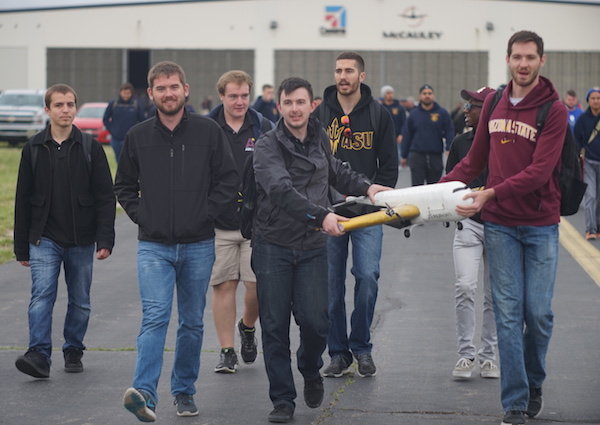Gaining elevation: ASU aeronautics team on the rise

The Air Devils team pictured at the American Institute of Aeronautics and Astronautics (AIAA) Design/Build/Fly competition: (back row, from left) Ivan Kruts, Andrew Morden, Nathan Stone, AJ Verbin, Ben Anderson, Ryan Spiller and Brendan Hernandez; and (front row, from left) Don Wood, Walter Bonar, Jeffrey Kirkman, and faculty adviser and professor of practice Timothy Takahashi. Airplanes are Production Aircraft (left) and Manufacturing Support Aircraft.
Arizona State University’s Air Devils rose to new heights during the spring semester, most notably making a significant jump in the rankings in a major international student aviation competition.
The club’s team of aerospace and mechanical engineering students in ASU’s Ira A. Fulton Schools of Engineering finished among the top performers in the 2016 American Institute of Aeronautics and Astronautics (AIAA) Design/Build/Fly competition.
From 145 teams that initially entered the competition, 80 were selected to move to the second and final phase. In the end, the Air Devils finished in 14th place among those teams, up from 23rd place last year.
Their ranking was earned with an especially strong showing in the competition’s flight challenges event at the Cessna Aviation company’s campus in Wichita, Kansas.
The ASU team was one of only 13 to complete all three flight missions, and one of only nine to receive a perfect flight score for each of those missions.
Ten Air Devils members traveled to the event, but as many as 50 had helped craft the team’s two small remote-controlled airplanes over the past six months, said Jeffrey Kirkman, the club’s president for the past year.
The planes were required to be electrically powered, using only specific kinds of batteries (nickel metal hydride) and commercially available electronics for propulsion, radio control and other systems. Everything else had to be hand-designed and made by students from various materials of their choosing.
“A big part of our improvement this year is due to the extra effort we put into compiling more data,” he said.
The team conducted more extensive research and testing to better understand the aerodynamics and mechanics involved in enabling their aircraft to perform well.
One plane was about 4 feet long with a 40-inch wingspan. The other was about 3 feet long with a 30-inch wingspan.
For the AIAA competition, student teams had to first attempt to get the larger of their two planes to complete a flight of three laps around a winding course within five minutes.
Air Devils team members carry their Manufacturing Support Aircraft to the starting line for one of the Design/Build/Fly competition flight missions. Pictured are (back row, from left) Ivan Kruts, Nathan Stone, Brendan Hernandez and Walter Bonar; and (front row, from left) Jeffrey Kirkman, AJ Verbin and Ben Anderson.
In mission two, the smaller plane had to be completely contained within the larger aircraft and then complete a similar flight pattern.
In mission three, the smaller plane was loaded with a 32-ounce bottle of Gatorade and required to do three laps around the course.
For all missions, the planes had to get airborne within 100 feet from the starting point of the takeoff run.
“We’re proud that we completed all the missions successfully with our planes intact,” Kirkman said. “Some teams walked away with their airplanes in pieces.”
Along with Cessna Aircraft Company, the Raytheon Company joined the AAIA in sponsoring the event and providing judges for the competition.
Kirkman attributes advances in the club’s work to the mentoring of the Air Devils’ faculty adviser Timothy Takahashi, a professor of practice in the mechanical and aerospace engineering program in the Ira A. Fulton Schools of Engineering.
“He’s dedicated to the students and spends a lot of time with us in the workshop teaching and helping us solve problems,” Kirkman said.
Kirkman has been with the Air Devils for three years and said he has learned as much or more from club projects than in some of his classes.
“It’s good hands-on learning about engineering design and engineering processes, and about team dynamics and facing challenges. Experience in national and international competition also looks good on your résumé,” he said.
Competitions such as the AIAA Design/Build/Fly event also give students opportunities to network with potential employers, said Kirkman, who earned his master’s degree in aerospace engineering this semester and will soon begin a job with Cessna.
Club members are determined to build on the momentum they gained at this year’s competition, said Don Wood, the new Air Devils president, who is pursuing a master’s degree in the aviation management and human factors program.
“Our Design/Build/Fly team overcame a lot of technical obstacles this year, and we’ll take the lessons learned from those challenges and roll them into devising our strategy for next year,” Wood said.
He is in his fourth year with the club and has “seen it grow by leaps and bounds to become a serious competitor at the AIAA competition, beating out teams in recent years from Embry Riddle Aeronautical University, Stanford, USC and MIT,” he said. “As president, I plan on maintaining the high standards that have enabled the team to rise to this status.”
More Science and technology

Cracking the code of online computer science clubs
Experts believe that involvement in college clubs and organizations increases student retention and helps learners build valuable…
Consortium for Science, Policy & Outcomes celebrates 25 years
For Arizona State University's Consortium for Science, Policy & Outcomes (CSPO), recognizing the past is just as important as…

Hacking satellites to fix our oceans and shoot for the stars
By Preesha KumarFrom memory foam mattresses to the camera and GPS navigation on our phones, technology that was developed for…
